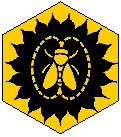 Glenn Apiaries
Glenn Apiaries
|
Located in southern California, halfway between San Diego and Los Angeles. Glenn Apiaries is nestled in a rural valley surrounded by avocado and orange groves, oak trees, and chaparral. Our Mediterranean climate provides nearly perfect conditions for raising queen bees.
The breeding of bees for genetic Here are methods we use in a commercial queen breeding operation, which produces about 2000 instrumentally inseminated queens annually, from February to September. Breeder queens of several mite resistant lines, including VSH (Varroa Sensitive Hygiene), Hygienic Italian, Carniolan, Russian, and Cordovan Italian are distributed to commercial and hobby queen breeders. Custom breeding is also carried out for bee researchers needing queens of specific crosses. This system to produce inseminated queens requires the coordination of several subsystems: queen rearing, queen banking, drone rearing and banking, semen collection, insemination, queen introduction into nucs, and colony evaluations. Each of these steps requires it’s own record keeping system, and must be timed to insure that the proper queens and drones are sexually mature simultaneously
Grafting Queens The first step in queen rearing is selecting the best queens to be the breeder queens. Bee breeding tests are carried out to select queens which are disease resistant as well as good honey producers. Young larva (< 24 hrs old) of the breeder queens are transferred into artificial queen cell cups. Larva are timed by giving the breeder an empty comb to lay eggs in four days before grafting.
The queen cells are then placed in a queenless "starter"colony.
On the tenth day after grafting the cell are removed to an incubator for one final day before they hatch into bottles.
Virgin queens are banked in a queenless colony for about a week before they are ready to be inseminated. Drone Production Our location in southern California, USA is in an Africanized honeybee area, so a secure system of raising drones of known parentage is essential. Empty frames of drone comb are placed in colonies which have been selected for desirabl
Semen is collected in a capillary tube from about 200 drones, enough to inseminate 20 queens
The semen is allowed to naturally mix for 24 hours to insure that each queen receives the maximum genetic diversity in the 8 micro liters of semen with which she is inseminated. After insemination, each queen is introduced into a small nuc with a push-in cage.
The queen is allowed to lay a good brood pattern to prove her fertility before being shipped to her new home.
Questions? Comments? Contact Glenn Apiaries at: Glenn Apiaries,
P.O. Box 2737, Fallbrook, CA 92088-2737
De Luz, CA rainfall records 1967- Present
|
What's happening in the Bee WorldBeginning beekeepers click here for advice on getting started in beekeeping.
|